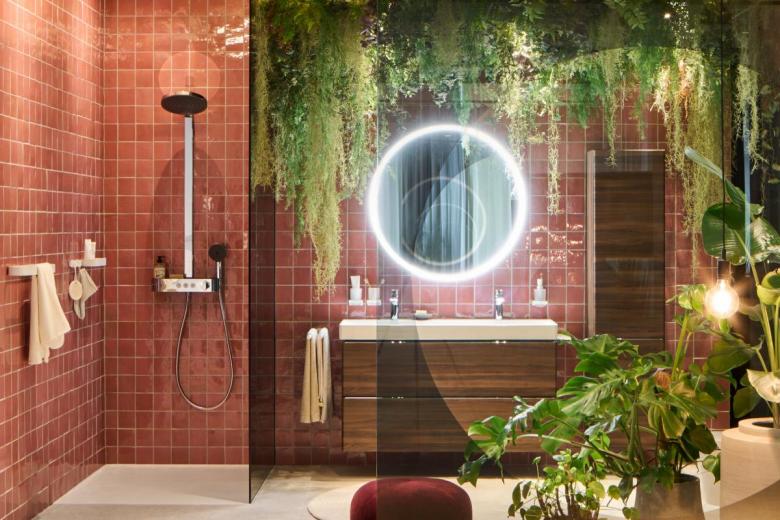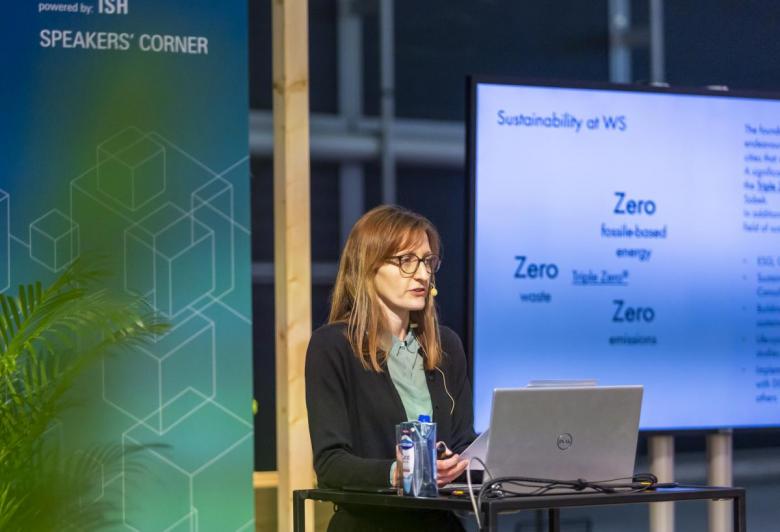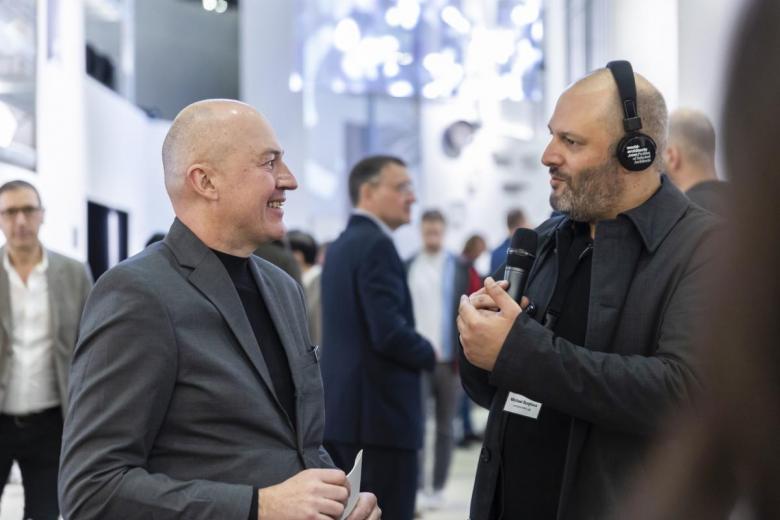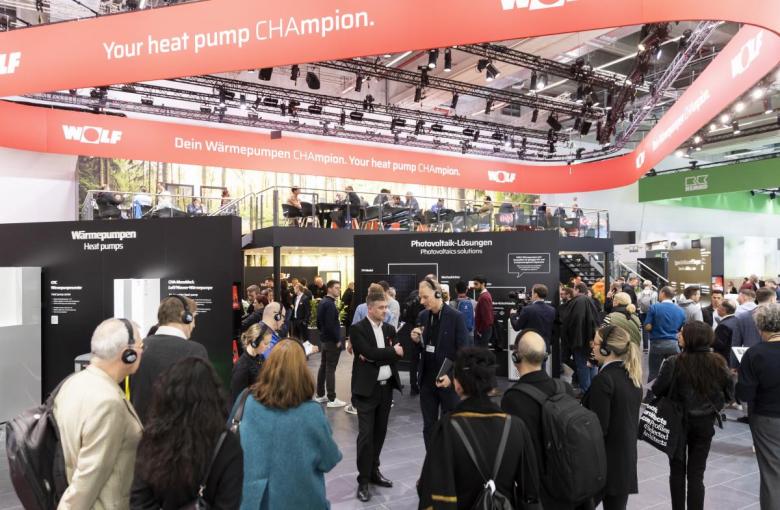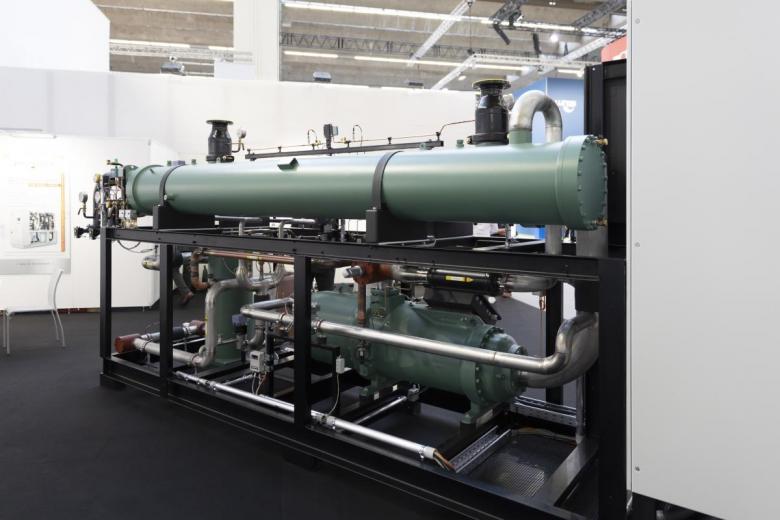Sanitary and heating industry turns to sustainability
Leonhard Fromm
22. March 2023
Dream bathroom at ISH 2023 (Photo © Philip Kottlorz / IF Group / Hansgrohe)
Once again, a host of innovations were on display at this year's ISH in Frankfurt. New developments from the industries promise to open up many possibilities for a construction industry capable of implementing a circular economy.
Separating urine in the toilet and turning it into fertilizer in a reactor installed in the basement is one of the most avant-garde products on show at this year's ISH in Frankfurt. After a four-year break caused by the pandemic, almost 154,000 visitors, 44 percent of them from abroad, were inspired for five days in mid-March by 2025 exhibitors from the sanitary, heating, air-conditioning and ventilation industries.
Sufficiency (avoidance), efficiency (improvement) and sustainability (regenerative energies, circular economy) were at the center of the industry's trade show. It also became clear that digitization, keyword smart grid, and cooperation across manufacturer and product boundaries are mega trends that must be embraced by anyone who wants to stay in business in the future. As Alexandra Mrzigod, structural engineer responsible for sustainability at Werner Sobek AG in Stuttgart, said at a Talk by World-Architects: "If those two firms, who install products in front of and behind the bathroom wall, were to cooperate, this would already unlock enormous potential in terms of product design, processing and assembly."
Alexandra Mrzigod, Werner Sobek AG – lecture at ISH 2023: "Building refurbishment – how we can achieve our climate goals" (Photo: Koy + Winkel / World-Architects)
Themed tours of the trade fairTo ensure that no one in the twelve exhibition halls lost their overview, World-Architects had again asked eight professionals from the architecture scene to prepare two-hour guided tours, spread over the five trade fair days, on topics such as holistic design, natural energy sources or trends. In each tour, groups of 15 to 30 building planners specifically visited exhibitors for three to eight minutes, who introduced their topic, answered a maximum of three questions and provided their contact for a later visit to the stand or for more in-depth discussions after the trade fair.
The Guided Tours, which are as popular as they are well-established and for which the Chamber of Architects awards further education credits, were roughly divided into the areas of water and energy. In each thematic area, the range from single-family homes to large hotels, apartment blocks or industrial plants was addressed, as was the entire range from simple functionality to pure luxury, which is offered above all by manufactory-like and very design-savvy niche suppliers such as Cea or :inbani, both from Italy. The latter boasts, for example, a solid marble washstand resembling an antique Greek column in its product range, which is reportedly available for just under 20,000 euros.
Guided Tour by Michael Burghaus "New sanitary technology and building services for sustainable architecture" (Photo: Koy + Winkel / World-Architects)
Lectures and guided toursA good way to get in the mood for a guided tour and sharpen one's own focus was to attend lectures such as the one given by Cologne-based designer Frank A. Reinhardt, who spoke in Hall 3.1 on the "Ten Trends in the Bathroom" and provided plenty of tips for planners and craftsmen. He recommended, for example, to focus on water-saving measures; or on the target group of retirees who want to prepare their own bathroom for their eventual need for care; or on wellness enthusiasts, for whom the sanitary area is increasingly becoming an extended living space and bedroom with spa character and furnishings.
Michael Burghaus, university lecturer for urban planning in Kaiserslautern, took his participants to the stand of the Swiss sanitaryware manufacturer Laufen Bathrooms, which recently became part of the Spanish Roca Group. This alone is an indication of how suppliers in the industry are globalizing, market segments are merging to form entire value chains that are coordinated with one another. What's exciting here: The Melinda Gates Environmental Foundation in the USA holds a patent on a process for separating urine in toilets. ETH Zurich, in turn, has a process for turning urea into fertilizer. Laufen has turned both into a product solution that is now to be marketed. The toilet bowl has a recessed channel at the front that separates 80 percent of the urine. The solution is already available and economical from 60 residential units, according to reports. The reactor that extracts fertilizer from the liquid will then be located in the basement of a high-rise building.
The Swiss are also reversing the water-saving principle for toilet flushing in order to save even more water. The idea is that the large button of the flush plate will in future be used for the "small business" and represents the frequency of use. The small button, on the other hand, flushes away the "big mess." And because the previous principle has become a global industry norm, the reverse wiring will be done behind the wall for the time being. A hotelier offering 100 rooms can reprogram the flushing via app and communicate it to his guests. A good example of psychological insights, says Michael Burghaus. The freelance architect and lecturer on sustainability from Kaiserslautern had put together the tour and eloquently guided the group.
Burghaus, who visited a total of nine exhibition stands during his two-hour tour, also took the participating architects to exhibitors from the heating/cooling sector in Hall 4. It was noticeable that "material battles" with brochures and flyers are in full retreat: Many booths are emblazoned with QR codes that you can use to get information on your smartphone; occasionally, memory sticks with the information are handed out on request; and more and more often you can have your e-mail address scanned to receive specific information.
Guided Tour by Markus Pfeil "Holistic Engineering – Produkte und Wege" (Photo: Koy + Winkel / World-Architects)
News from building technologyObviously, the heat pump was on everyone's lips during the five trade fair days, not least because earlier this year the German government brought forward the decision to phase out fossil fuel heating systems by one year to 2024. Another reason is that mechanical solutions that do without refrigerants are often ignored, and because there are plenty of alternatives to air as a heat source, but hardly anyone talks about them either. In any case, hybrid solutions are superior for several reasons, participants in World-Architects' tours have learned.
During an excursion through Halls 8, 11 and 12, 20 architects were in the good hands of Markus Pfeil. The professor in the field of Holistic Technical Building Equipment at the MSA | Münster School of Architecture is an expert on sustainability and complains that solar thermal energy and biomass were hardly noticeable at ISH. This was all the more regrettable, he said, because heat pumps are based not only on air, but also on these and other sources such as geothermal energy.
In addition to heating sources, the solutions of which were presented primarily in Halls 11 and 12, ISH also focused on the distribution of heat in the building. For example, Roth-Werke from Dautphetal-Buchenau, which cooperates closely with Lotter KG from Ludwigsburg, presented surface heating and cooling systems with short response times in Hall 4. With this solution, the heating pipes are laid directly in the floor slab at a grid spacing of just 1.3 centimeters below the floor already during shell construction. This saves on screed and therefore shortens the construction time. The system also works in walls and is operated with flow temperatures of 24 to 36 degrees, which in turn affects the lead time. In summer, the Roth solution is also suitable for cooling.
